|
 Dwight Peck's personal website Dwight Peck's personal website
Mabamba
Bay in November 2005
Bring
your wellies.
The
Ramsar Convention on Wetlands held its 9th meeting of the Conference of the Contracting
Parties at the Speke Resort in Munyonyo, about five miles outside of Kampala,
Uganda, on Lake Victoria. Work, work, work, from the 4th to the 16th, and then
-- then, it was over. So our companions are off to do some birdwatching,
and we're off to watch some birdwatchers. (Much to be learnt about obsessive-compulsive
disorders, etc.) 
Way too
early in the morning! Dwight, Tobias, and Sandra await their guide for a day of
birdwatching at Mabamba Bay. (Photo by Nick)

A preliminary
stop near Mpigi on the way to Mabamba Bay, ogling birds in the papyrus swamp.
On the right is our exceptionally great guide, Mr Herbert
Byaruhanga, director of Bird Uganda Safaris ['the papa of Uganda tourism'], who is not only a successful
nature tour operator but a well known conservationist as well, sought after for
his experience in designing programmes for exciting schoolchildren about the wonders
of the wetlands. (If ever you're in Uganda and want to see birds, you cannot do
better than www.birduganda.com, director@birduganda.com.)
Here
Ramsar people Tobias, Sandra, and Nick mimic bird calls and gaze in rapture, with
Herbert (right) and his 11-year-old son Davis, who's meant to take over the business
and who saw the second Shoebill of his short life today.

Herbert
hears a rustle in the papyrus and we all get busy with our binoculars. "Over
there, right near the papyrus!"

Now we're
here at Mabamba Bay (the red circle on the map), which is a big swamp,
and also a BirdLife International "Important Bird Area (IBA)" and, according
to Herbert, recently nominated to be a Wetland of International Importance under
the Ramsar Convention. [Update: "Mabamba Bay Wetland
System" was added to the Ramsar List as of 15 September 2006.]

From
the carpark, a little mud in the main channel (Lake Victoria's water level is
dropping ominously), so here the Ramsar birdwatching team
march on artificial aids swampwards to some boats that can hold our weight. (Photo
by Tobias)

Along
the way, we pass some serious sound equipment being dragged in over the mud from
some crazy swamp party last night.

Tobias
passes still more goods coming in the hard way. He's wearing the attractive Ramsar
COP9 commemorative baseball cap, probably as a sardonic joke.

The entrepot
of swamp boats, waiting for occupants. Each of them has an endearing name painted
on the floorboards, like "Elvira", "Magdalena", and "Mbubu".

Having
finally found our boat, our guide had some very difficult poling to get free of
the mud. The narrator was probably right to think that he was the cause of the
problem, and offered to leap overboard if it would make a difference.

Finally
free of the mud, even with the narrator still aboard, we are blasting off across
the Mabamba Bay swamp in search of remarkable birds.
And especially -- dare one hint at it?? -- the Shoebill.
(Formerly called the "Shoebill Stork", until someone took the notion
that it looks more like a pelican, so now it's just the "Shoebill".)
Some people will KILL for a glimpse of a Shoebill.

Water
hyacinth (Eichhornia crassipes), one of the most vicious of all alien invasive
species, which has gone far to choking off all of Lake Victoria and can be seen
here working its way up the channels of Mabamba swamp.
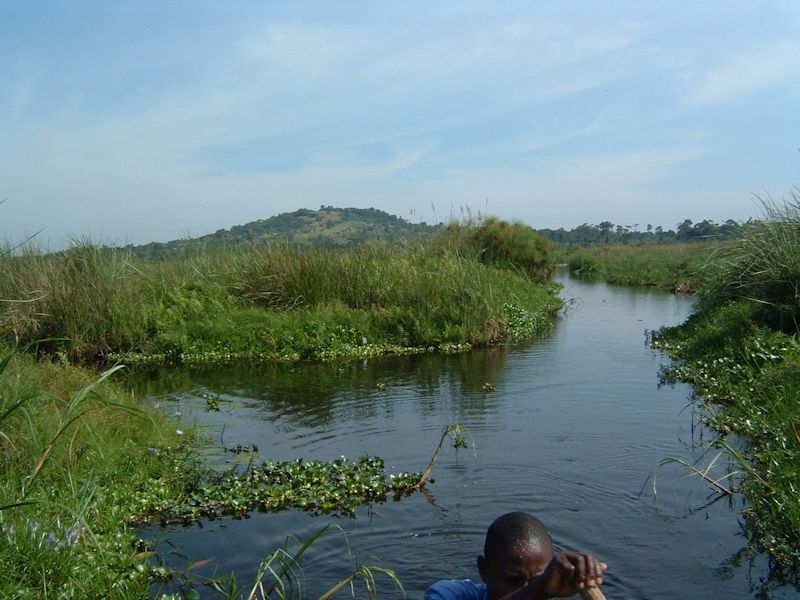
Little
islands of the water hyacinth stuff growing out from the shore, breaking free,
drifting wherever the Benevolent God wishes to take them, and then proliferating
again into vast mats, so that fish can't live in the deoxygenated water and the
fishermen have to machete their way two kilometers out into Lake Victoria to reach
open water.
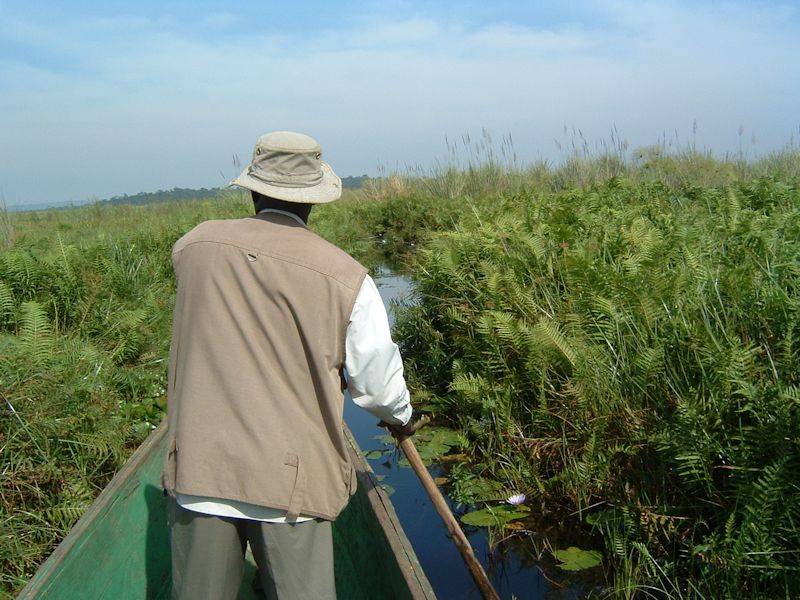
Herbert
Byaruhanga is on the lookout for a Shoebill!
So far with no success. So he hauls out his cellphone, dials up, and murmurs a
few words and then pockets it away again.
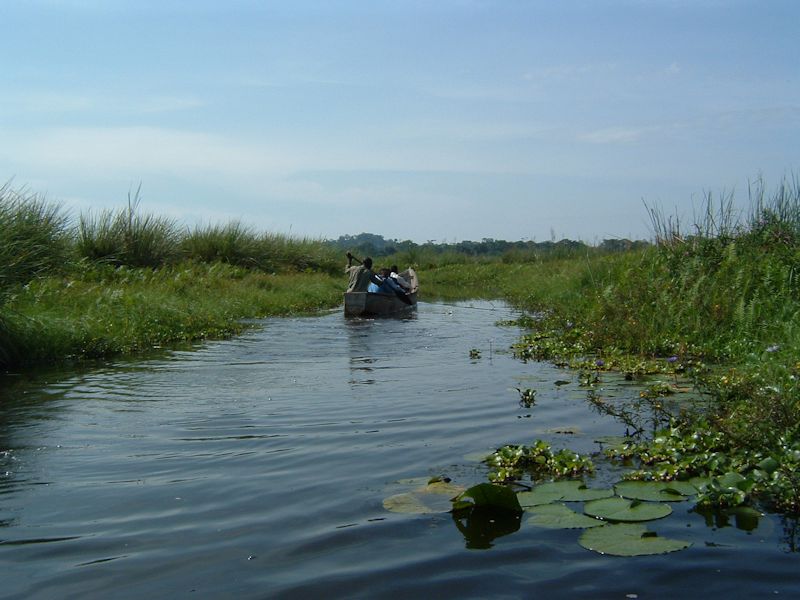
Traffic
in the swamp. These folks don't seem to be birdwatchers. In fact, they seem to
be commuters, just on their way to the other side of the swamp after a good day's
work.

Herbert
gets a call on his cellphone, and abruptly we're backing out of one channel and
edging our way up into another, this one nearly choked off already by the
water hyacinth.
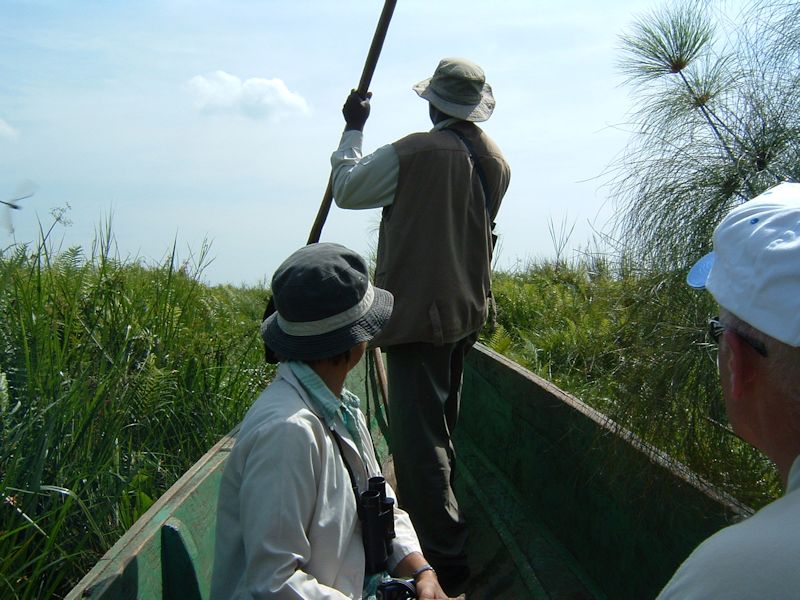
Herbert,
ever vigilant, has got news of the Shoebill and will get us there whatever may
lie ahead.
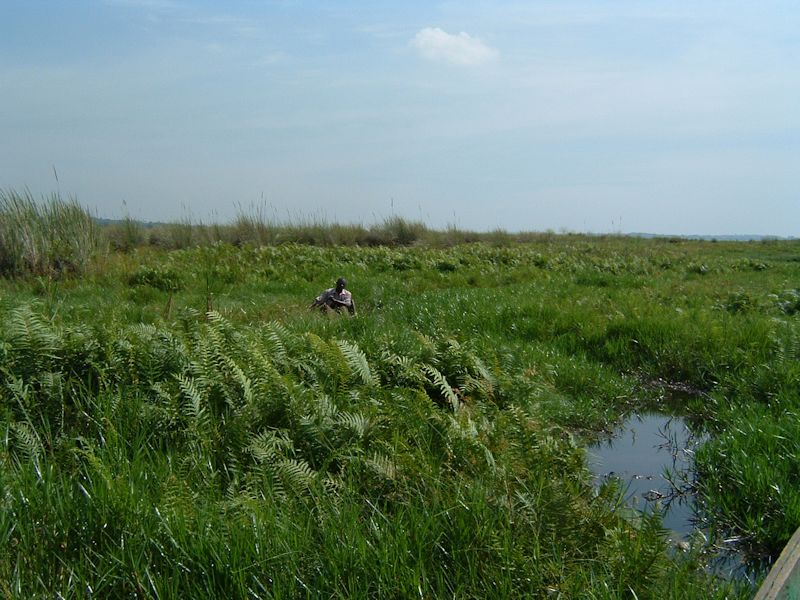
Herbert's
colleague, a local man whom long ago Herbert trained up as a birdwatcher guide,
approaches silently to confirm his recent telephone call and the present location
of the elusive Shoebill.

There's
the elusive Shoebill. Lifelong birdwatchers groan and slap themselves, having
searched for the Shoebill continuously and now viewing their second one in the
past ten years. In fact, one of our party yanked out his own cellphone and text-messaged
his girlfriend in England to say that he'd finally seen another one.
(Reply: "That's
nice, dear.")
Definitely
a moving experience.
This big, horribly
ugly and probably useless Shoebill. But RARE, like the 1909S VBD penny for coin
collectors. Rare, cool, but still -- really really ugly.

On
the way back, though, here's a cute kingfisher that's got a little more color
to it. Smaller than a Shoebill, perhaps, but prettier. And maybe tastier.

The
graveyard of abandoned boats.
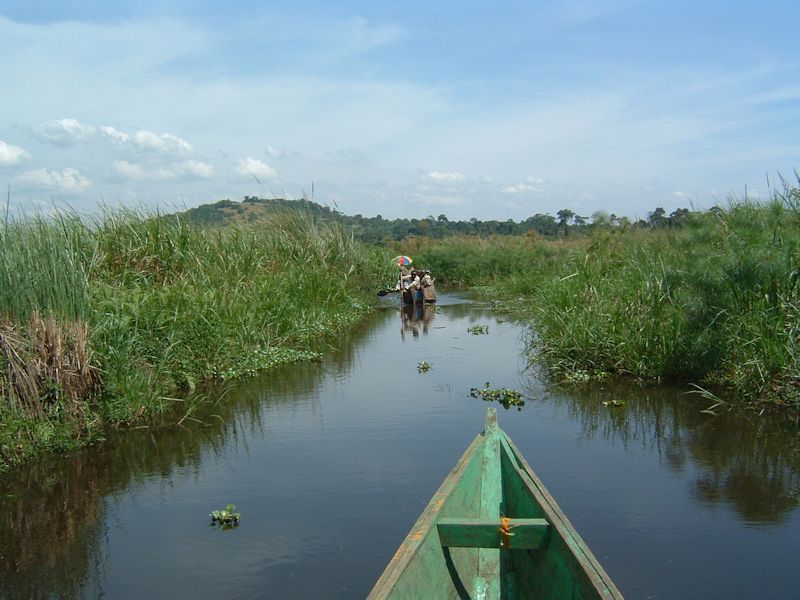
More
traffic on the swamp, and someone coming along with a parasol against the sun.

The Mabamba Regatta

Back
at the trailhead, it's almost time to go to the airport in Entebbe.

Sandra
and our rower/poler, who thought nothing of leaping out of the boat to push from
alongside, where, from time to time, we saw snakes that were bigger than he is,
and certainly bigger than Sandra.

 Feedback
and suggestions are welcome if positive, resented if negative, Feedback
and suggestions are welcome if positive, resented if negative,  .
All rights reserved, all wrongs avenged. Posted 14 December 2005, revised 21 June
2007, 20 July 2013. .
All rights reserved, all wrongs avenged. Posted 14 December 2005, revised 21 June
2007, 20 July 2013.
|
 Dwight Peck's personal website
Dwight Peck's personal website






















